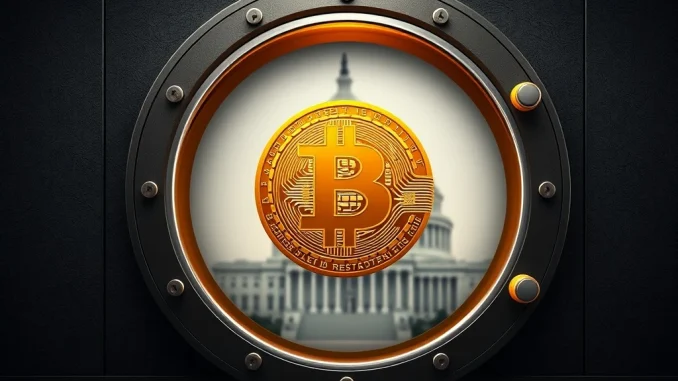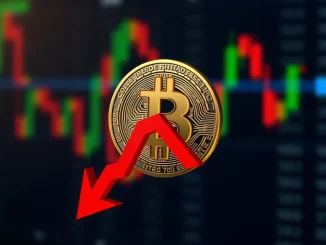
Get ready for a potentially seismic shift in how the United States approaches digital assets. A landmark report from the President’s Digital Asset Working Group is set to drop on July 30, and it’s sparking significant discussion across the financial world. At its core, the report delves into the feasibility of establishing a Strategic Bitcoin Reserve, a concept that could redefine the nation’s financial posture in the digital age. This isn’t just about holding onto seized cryptocurrencies; it’s about a calculated, long-term strategy inspired by historical gold reserves. What does this mean for Bitcoin’s future, and how will it impact the broader crypto market? Let’s dive in.
What is the Proposed Strategic Bitcoin Reserve?
Imagine the U.S. government holding a substantial stash of Bitcoin, not just as seized assets, but as a strategic reserve, much like gold. That’s precisely what the upcoming report from the President’s Digital Asset Working Group proposes. Compiled over 180 days, this document outlines a vision for a national Bitcoin Reserve, with a striking recommendation: a 20-year holding period. This long-term outlook directly mirrors the stability-focused strategies traditionally applied to gold reserves, suggesting a significant shift in perception towards Bitcoin as a durable asset.
- Leveraging Seized Assets: The report is expected to recommend utilizing existing Bitcoin holdings, primarily those seized by law enforcement agencies, as the foundational layer for this reserve.
- Budget-Neutral Expansion: Beyond existing assets, the document explores methods for acquiring additional Bitcoin without directly impacting the federal budget, potentially through innovative financial mechanisms or partnerships.
- Long-Term Vision: The proposed 20-year holding period signals a belief in Bitcoin’s enduring value and its potential role in national economic stability.
Shaping US Bitcoin Strategy: A New Era?
The release of this report could mark a pivotal moment for US Bitcoin Strategy. For years, the government’s approach to digital assets has been largely reactive, focusing on regulation and enforcement. This new proposal, however, indicates a proactive shift towards integrating Bitcoin into the nation’s strategic asset portfolio. If implemented, such measures could significantly boost Bitcoin’s legitimacy and drive demand, potentially influencing its market dynamics for years to come.
This evolving strategy is not happening in a vacuum. Legislative efforts are already underway, complementing the executive branch’s initiatives:
- The GENIUS Act: Recently signed into law, this act may lay groundwork for digital asset integration, though its specific impact on a reserve is yet to be fully seen.
- The Proposed BITCOIN Act: This ambitious bill aims to direct the Treasury to purchase 1 million BTC over five years, a clear signal of growing political interest in institutionalizing Bitcoin as a strategic asset. Such a move would undeniably shape the US Bitcoin Strategy in a dramatic fashion.
Navigating Crypto Regulation Challenges
While the prospect of a national Bitcoin Reserve is exciting, it comes with its share of challenges, particularly concerning Crypto Regulation. Bitcoin’s inherent volatility presents unique hurdles for government asset management. Experts highlight several key concerns:
- Volatility Management: How will a government entity manage a reserve composed of an asset known for its price swings? Strategies for hedging or mitigating risk will be crucial.
- Security Risks: Holding large amounts of digital assets demands top-tier cybersecurity protocols to prevent hacks and theft.
- Accounting Complexities: Integrating a volatile digital asset into federal accounting frameworks will require new standards and practices.
- Market Manipulation Concerns: Large-scale government buying or selling could be perceived as market manipulation, raising questions about fiscal responsibility and fair market practices.
To address these, significant congressional activity is underway. The Senate Banking Committee is actively advancing a crypto market structure bill, aiming to clarify regulatory oversight between the SEC and CFTC. This coordinated push is essential for establishing a robust Crypto Regulation framework that balances innovation with investor protection.
The Impact on Digital Asset Policy and Markets
The working group’s final recommendations will likely have profound implications not only for Bitcoin’s market dynamics but also for the broader acceptance of digital assets in mainstream finance. This report represents a significant step in formalizing a comprehensive Digital Asset Policy at the federal level. The very discussion of a national reserve signals a maturation of the crypto space, moving beyond speculative investment to strategic national interest.
Investors are keenly watching how these policies align. A coherent and well-defined Digital Asset Policy could significantly accelerate institutional adoption, drawing in more traditional financial players. Conversely, missteps or unclear frameworks could deter this crucial influx of capital and expertise. With Bitcoin trading near $119,000 as of the report’s discussion, market participants are already interpreting the potential for government buying as a bullish signal, highlighting the immediate market impact of such a policy shift.
Understanding Government Bitcoin Holdings and Their Future
Currently, the U.S. government holds a substantial amount of Bitcoin, primarily from law enforcement seizures. The report aims to bring these disparate Government Bitcoin Holdings under a unified strategic umbrella. Instead of merely holding seized assets, the proposal suggests actively managing and potentially expanding these holdings as part of a national reserve. This reclassification transforms them from incidental assets to deliberate strategic investments.
The shift from passive holding to active management of Government Bitcoin Holdings raises questions about transparency, auditing, and the criteria for future acquisitions. If the Treasury is indeed directed to purchase 1 million BTC as per the proposed BITCOIN Act, it would make the U.S. one of the largest sovereign holders of Bitcoin, a move that would undoubtedly ripple across global financial markets. The debate continues on the practicality of sustaining such long-term holdings in a volatile asset, but the direction is clear: Bitcoin is increasingly viewed as a legitimate, strategic asset by powerful government entities.
The forthcoming U.S. report on a Strategic Bitcoin Reserve marks a monumental moment for the crypto world. By proposing a 20-year holding plan inspired by gold, the U.S. government signals a profound shift in its approach to digital assets. While challenges like volatility and regulatory clarity remain, the coordinated efforts from executive and legislative branches underscore a growing recognition of Bitcoin’s strategic importance. This move could not only reshape the nation’s financial future but also accelerate Bitcoin’s journey into mainstream finance, solidifying its place as a legitimate, long-term asset. The world watches to see if this ambitious plan will unlock a new era for digital assets.
Frequently Asked Questions (FAQs)
Q1: What is a Strategic Bitcoin Reserve?
A Strategic Bitcoin Reserve is a proposed initiative where the U.S. government would hold a significant amount of Bitcoin as a national asset, similar to how it holds gold reserves. The goal is to leverage these holdings for long-term financial stability and strategic advantage.
Q2: How would the U.S. government acquire Bitcoin for this reserve?
The report suggests two primary methods: utilizing existing Bitcoin seized by law enforcement agencies, and exploring budget-neutral methods for acquiring additional Bitcoin, potentially through new financial mechanisms or direct purchases as proposed by legislation like the BITCOIN Act.
Q3: Why is a 20-year holding period being considered for the Bitcoin Reserve?
The 20-year holding period is inspired by gold reserve strategies, emphasizing a long-term outlook on Bitcoin’s value and stability. It indicates a belief that Bitcoin, despite its current volatility, will mature into a durable and strategically important asset over an extended period.
Q4: What are the main challenges of establishing a government Bitcoin Reserve?
Key challenges include managing Bitcoin’s price volatility, ensuring robust cybersecurity for large digital asset holdings, developing new accounting frameworks for a volatile digital asset, and addressing concerns about potential market manipulation due to large-scale government buying or selling.
Q5: How might this report impact Bitcoin’s market dynamics?
The potential for the U.S. government to become a significant long-term holder and buyer of Bitcoin is generally seen as a bullish signal, potentially driving increased demand and legitimacy for the asset. It could also accelerate institutional adoption and influence broader digital asset policy.
Q6: What role do legislative efforts like the GENIUS Act and BITCOIN Act play?
These legislative efforts complement the executive branch’s initiatives by providing a legal framework for digital asset integration and potentially mandating specific actions, such as the Treasury purchasing Bitcoin. They underscore growing political interest in formalizing Bitcoin’s role as a strategic asset within federal policy.



